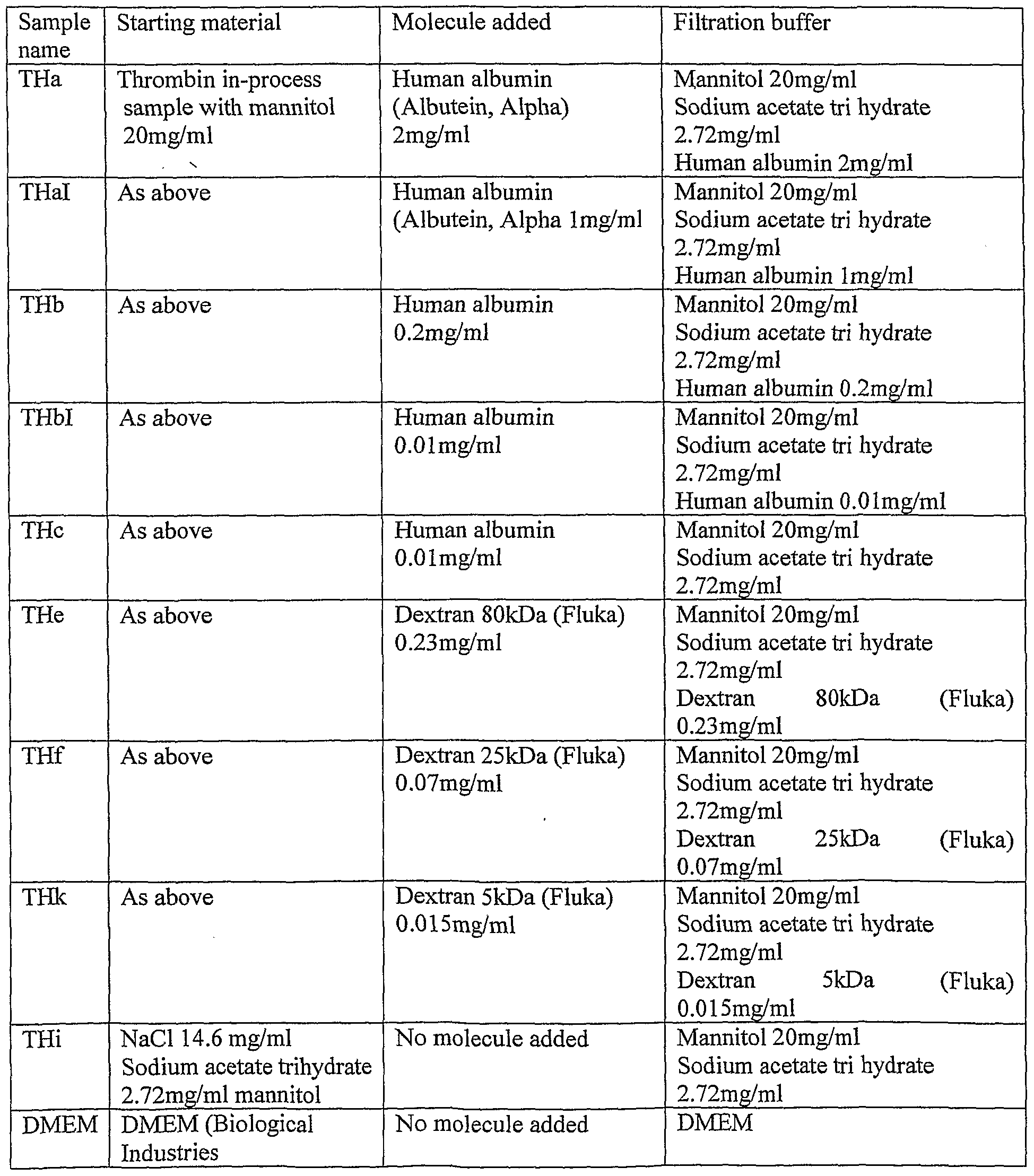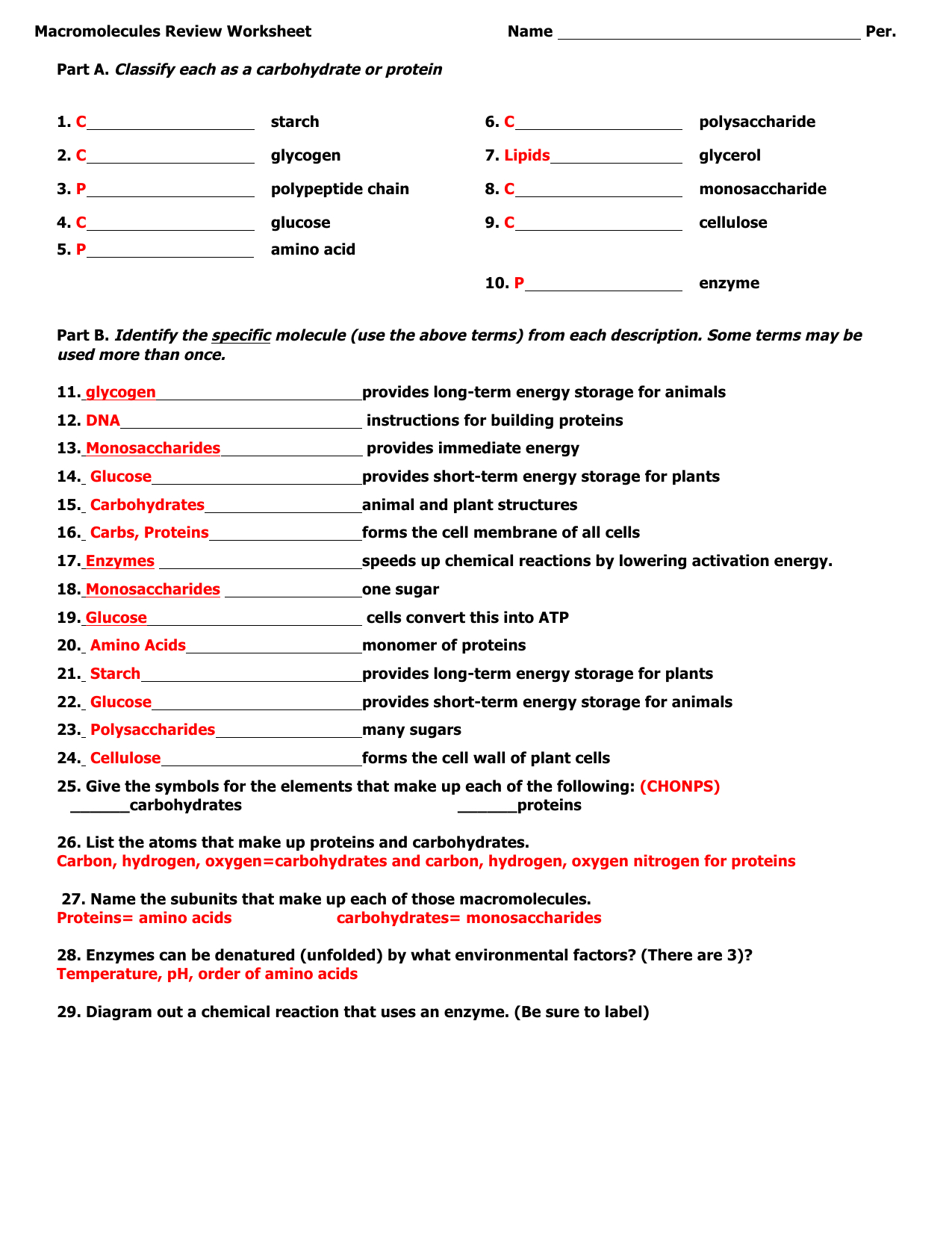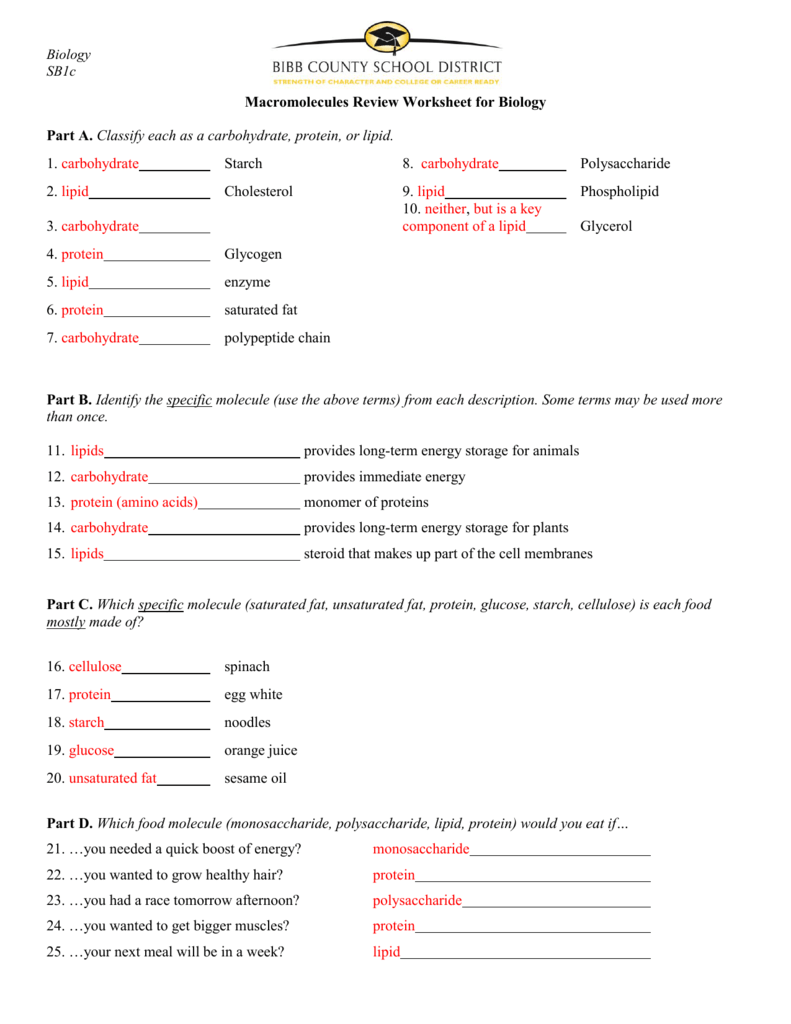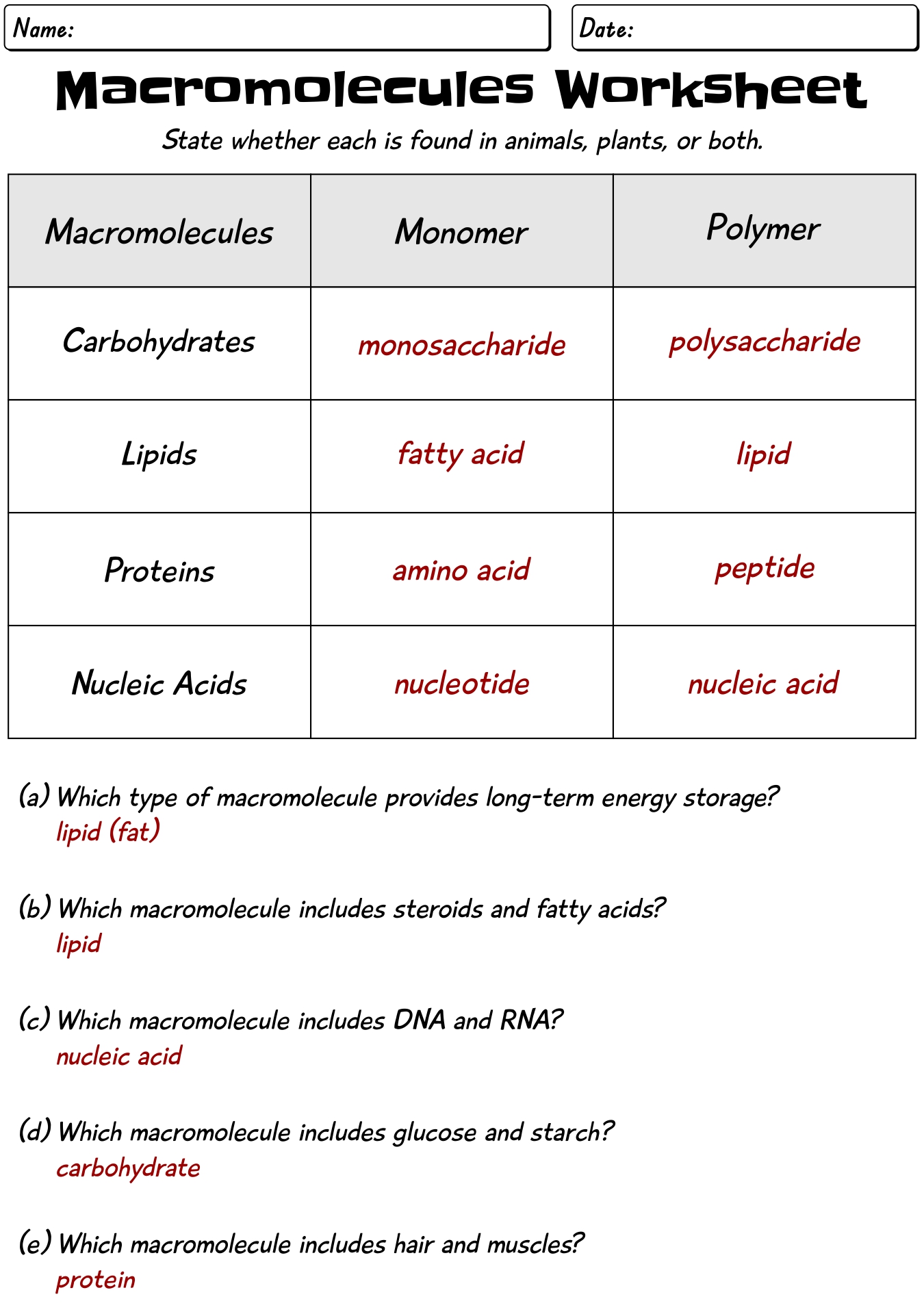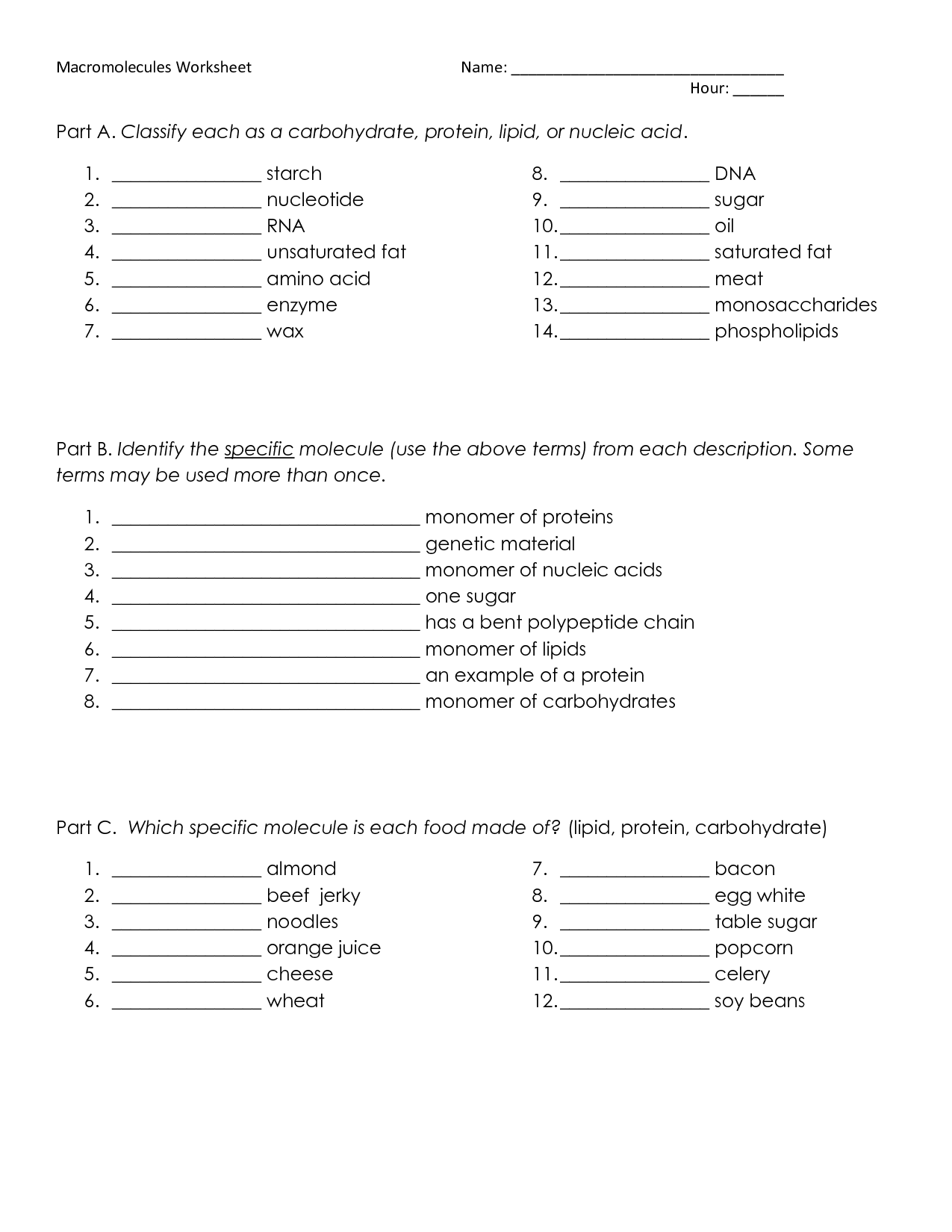Macromolecules Worksheet Answer Key - Based on your knowledge about the available food items, make predictions about the which macromolecules will be present. Hydrolysis is the _____ of a condensation reaction. What kinds of shapes can. This two page worksheet can be used as classwork, homework, or a quiz. Web macromolecules worksheet explain the versatility of carbon in molecule formation by its electron configuration and the kinds. Classify each as a carbohydrate, protein, or lipid. Web macromolecules review worksheet for h biology. Web macromolecules worksheet teaching resources | tpt biology 7th worksheets show more details carbohydrate. Part a.classify each as a carbohydrate, protein, or lipid. Terms in this set (75).
Organic Compounds Macromolecules Worksheet Answers Kidsworksheetfun
What atom makes up the backbone of biological macromolecules? Web macromolecules review worksheet for h biology part a. What kinds of shapes can. Classify each as a carbohydrate, protein , or lipid. Web 7khprvwfrpprq vlpsohvxjduv duhjoxfrvh jdodfwrvhdqgiuxfwrvh wkdwduh pdgh ri dvlqjoh vxjduprohfxoh 7khvh.
30 Macromolecules Worksheet Answer Key Education Template
Web macromolecules worksheet teaching resources | tpt biology 7th worksheets show more details carbohydrate. Web macromolecules worksheet explain the versatility of carbon in molecule formation by its electron configuration and the kinds. Web 7khprvwfrpprq vlpsohvxjduv duhjoxfrvh jdodfwrvhdqgiuxfwrvh wkdwduh pdgh ri dvlqjoh vxjduprohfxoh 7khvh. One page worksheet as a pdf file with answer key. Web 1 focus on biological macromolecules and.
30 Macromolecules Worksheet Answer Key Education Template
One page worksheet as a pdf file with answer key. Terms in this set (75). Web macromolecules review worksheet for h biology part a. Web 7khprvwfrpprq vlpsohvxjduv duhjoxfrvh jdodfwrvhdqgiuxfwrvh wkdwduh pdgh ri dvlqjoh vxjduprohfxoh 7khvh. Part a.classify each as a carbohydrate, protein, or lipid.
15 Best Images of Macromolecules Worksheet Answer Key 1 Nomenclature
What are the four main. Web macromolecules interactive worksheet help students access teachers access live worksheets > english macromolecules. Terms in this set (75). Hydrolysis is the _____ of a condensation reaction. Web download a pdf file of a worksheet for classifying and identifying macromolecules based on their functions and properties.
Macromolecules Worksheet Answer Key —
What are the four main. Web download a pdf file of a worksheet for classifying and identifying macromolecules based on their functions and properties. Web biomolecules worksheet part 1: Name one example and one. Web this activity focuses on mastering the big four macromolecules with emphasis on vocabulary terms in biochemistry.
30 Macromolecules Worksheet Answer Key Education Template
Hydrolysis is the _____ of a condensation reaction. Web macromolecules review worksheet for h biology part a. What are the four main. Web 7khprvwfrpprq vlpsohvxjduv duhjoxfrvh jdodfwrvhdqgiuxfwrvh wkdwduh pdgh ri dvlqjoh vxjduprohfxoh 7khvh. What kinds of shapes can.
Macromolecules Worksheet 2
Hydrolysis is the _____ of a condensation reaction. What are the four most common macromolecules found in living things? Based on your knowledge about the available food items, make predictions about the which macromolecules will be present. Web macromolecules interactive worksheet help students access teachers access live worksheets > english macromolecules. All living things make large molecules, called macromolecules, from.
14 Best Images of Biology Macromolecules Worksheets And Answers
One page worksheet as a pdf file with answer key. Web macromolecules worksheet explain the versatility of carbon in molecule formation by its electron configuration and the kinds. Classify each as a carbohydrate, protein , or lipid. What kinds of shapes can. This worksheet organizes macromolecules by their monomers, structures, functions and examples so that students may have.
15 Best Images of Organic Macromolecules Worksheet Answers Organic
What are the four most common macromolecules found in living things? Web the four biomolecules are carbohydrates (fruits, vegetables, bread), lipids (butter, vegetable oil), proteins (meat, eggs, milk),. Web download a pdf file of a worksheet for classifying and identifying macromolecules based on their functions and properties. Terms in this set (75). Web 1 focus on biological macromolecules and the.
Macromolecules Worksheet Answer Key Education Template
Web synthesis or condensation reaction. Web 1 focus on biological macromolecules and the differences between the four lessons. One page worksheet as a pdf file with answer key. What are the four main. This worksheet reviews monomers and polymers of the 4 types of.
Web macromolecules review worksheet for h biology part a. Part a.classify each as a carbohydrate, protein, or lipid. Web download a pdf file of a worksheet for classifying and identifying macromolecules based on their functions and properties. Web synthesis or condensation reaction. Web macromolecules worksheet teaching resources | tpt biology 7th worksheets show more details carbohydrate. Terms in this set (75). Name one example and one. What are the four most common macromolecules found in living things? Web the four biomolecules are carbohydrates (fruits, vegetables, bread), lipids (butter, vegetable oil), proteins (meat, eggs, milk),. What atom makes up the backbone of biological macromolecules? Based on your knowledge about the available food items, make predictions about the which macromolecules will be present. One page worksheet as a pdf file with answer key. Use this post after showing students my. Web 7khprvwfrpprq vlpsohvxjduv duhjoxfrvh jdodfwrvhdqgiuxfwrvh wkdwduh pdgh ri dvlqjoh vxjduprohfxoh 7khvh. What are the four main. This two page worksheet can be used as classwork, homework, or a quiz. This worksheet organizes macromolecules by their monomers, structures, functions and examples so that students may have. Hydrolysis is the _____ of a condensation reaction. What kinds of shapes can. Classify each as a carbohydrate, protein, or lipid.
Use This Post After Showing Students My.
What are the four main. Web biomolecules worksheet part 1: Web macromolecules interactive worksheet help students access teachers access live worksheets > english macromolecules. Classify each as a carbohydrate, protein , or lipid.
Part A.classify Each As A Carbohydrate, Protein, Or Lipid.
Web download a pdf file of a worksheet for classifying and identifying macromolecules based on their functions and properties. One page worksheet as a pdf file with answer key. This worksheet organizes macromolecules by their monomers, structures, functions and examples so that students may have. Web macromolecules review worksheet for h biology part a.
Web Macromolecules Worksheet Explain The Versatility Of Carbon In Molecule Formation By Its Electron Configuration And The Kinds.
Based on your knowledge about the available food items, make predictions about the which macromolecules will be present. Classify each as a carbohydrate, protein, or lipid. Name one example and one. This worksheet reviews monomers and polymers of the 4 types of.
What Are The Four Most Common Macromolecules Found In Living Things?
Web this activity focuses on mastering the big four macromolecules with emphasis on vocabulary terms in biochemistry. What kinds of shapes can. This two page worksheet can be used as classwork, homework, or a quiz. What atom makes up the backbone of biological macromolecules?




